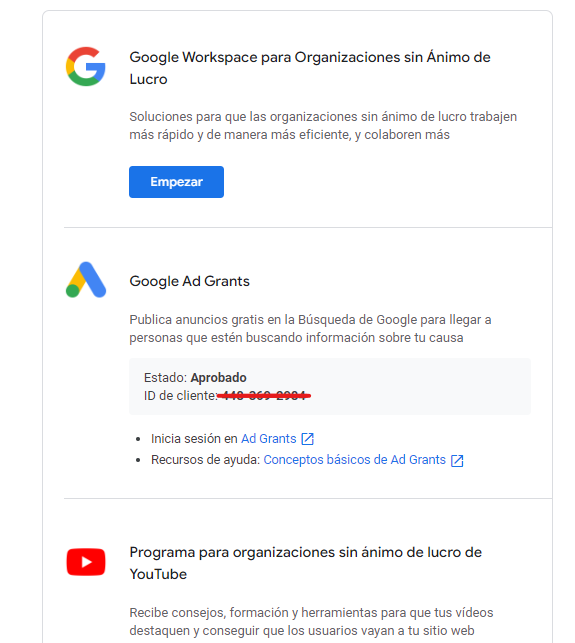Google Ad Grants para organizaciones Nonprofits. Publicidad gratis y como conseguirlo
3 min de lectura
Índice:
1º ¿Qué es Google Ad Grants?
2º Ventajas
3º Consejos
4º Como solicitarlo
5º Conclusión
Google, a través de su plataforma de publicidad, Google Ads,permite a los anunciantes mostrar sus anuncios en los resultados de búsqueda de Google, en sitios web asociados, en YouTube y en otras plataformas digitales. Google Ads ofrece una gran variedad de opciones para crear y optimizar campañas publicitarias según los objetivos, el público y el presupuesto de cada anunciante.
Pero, ¿sabías que Google Ads también puede ser una herramienta muy útil para las asociaciones sin ánimo de lucro teniendo la oportunidad de anunciarte 100% gratis? En este artículo, te explicamos cómo puede beneficiar Google Ads a las organizaciones que buscan generar un impacto social positivo.
¿Qué es el programa Google Ad Grants?
El programa Google Ad Grants es una iniciativa de Google que ofrece a las asociaciones sin ánimo de lucro la posibilidad de acceder a un crédito mensual de hasta 10.000 dólares para crear y gestionar campañas de Google Ads sin coste alguno. El objetivo del programa es ayudar a las organizaciones a difundir su misión, aumentar su visibilidad, captar donantes, reclutar voluntarios y promover sus acciones.
Para poder acceder al programa Google Ad Grants, las asociaciones sin ánimo de lucro deben cumplir una serie de requisitos, como estar registradas y tener un estatus legal reconocido en el país donde operan, tener un sitio web activo y de calidad, y aceptar las políticas y condiciones de Google.
Además, las organizaciones deben crear y mantener sus campañas de Google Ads siguiendo unas pautas específicas, como usar solo el tipo de campaña de búsqueda, tener un nivel mínimo de clics y conversiones, y no superar el límite de 2 dólares por clic.
¿Qué ventajas tiene usar Google Ads para las asociaciones sin ánimo de lucro?
Usar Google Ads para las asociaciones sin ánimo de lucro puede tener múltiples ventajas, como las siguientes:
Alcance y relevancia: Google Ads permite a las asociaciones sin ánimo de lucro llegar a millones de usuarios que buscan información relacionada con su causa, su sector o su zona geográfica. Al mostrar sus anuncios en los momentos y lugares adecuados, las organizaciones pueden aumentar su notoriedad, su credibilidad y su interés entre su público objetivo.
Segmentación y personalización: Google Ads ofrece una gran variedad de opciones para segmentar y personalizar las campañas publicitarias según las características, preferencias y comportamientos de los usuarios. Así, las asociaciones sin ánimo de lucro pueden adaptar sus mensajes, sus ofertas y sus llamadas a la acción a las necesidades y expectativas de cada grupo de usuarios, y mejorar su eficacia y su retorno de la inversión.
Medición y optimización: Google Ads facilita el seguimiento y el análisis del rendimiento de las campañas publicitarias, gracias a herramientas como Google Analytics, Google Tag Manager o Google Data Studio. Estas herramientas permiten a las asociaciones sin ánimo de lucro medir el impacto de sus anuncios en términos de tráfico, conversiones, donaciones, registros, etc., y obtener información valiosa para optimizar sus estrategias, sus presupuestos y sus resultados.
Innovación y creatividad: Google Ads también ofrece la oportunidad de experimentar con formatos, contenidos y técnicas innovadoras y creativas para captar la atención y el interés de los usuarios. Por ejemplo, las asociaciones sin ánimo de lucro pueden usar anuncios de vídeo, anuncios de display, extensiones de anuncios, anuncios dinámicos, anuncios
inteligentes, etc., para diferenciarse de la competencia y generar una mayor conexión emocional con su audiencia.
¿Qué consejos hay que tener en cuenta para usar Google Ads para las asociaciones sin ánimo de lucro?
Para aprovechar al máximo el potencial de Google Ads para las asociaciones sin ánimo de lucro, es importante tener en cuenta una serie de consejos, como los siguientes:
Definir los objetivos y las métricas: Antes de crear y lanzar una campaña de Google Ads, es fundamental definir los objetivos que se quieren conseguir con ella, y las métricas que se van a usar para medir su éxito. Los objetivos pueden ser de diferentes tipos, como generar conciencia, educar, informar, persuadir, movilizar, etc., y las métricas pueden ser de diferentes niveles, como impresiones, clics, visitas, conversiones, donaciones, etc. Establecer los objetivos y las métricas ayuda a diseñar y ejecutar las campañas de forma más eficiente y efectiva.
Investigar las palabras clave y la competencia: Otro aspecto clave para crear y gestionar una campaña de Google Ads es investigar las palabras clave y la competencia. Las palabras clave son los términos que los usuarios usan para buscar información en Google, y que determinan la aparición de los anuncios. La competencia son los otros anunciantes que también pujan por esas palabras clave, y que influyen en el coste y la posición de los anuncios. Investigar las palabras clave y la competencia ayuda a seleccionar las más adecuadas para cada campaña, y a optimizar las pujas y los presupuestos.
Crear anuncios atractivos y relevantes: Una vez seleccionadas las palabras clave, es hora de crear los anuncios que se van a mostrar a los usuarios. Los anuncios deben ser atractivos y relevantes, es decir, deben llamar la atención y ofrecer una solución o un beneficio al usuario. Para ello, es importante usar títulos y descripciones claros, concisos y convincentes, que incluyan las palabras clave, un valor diferencial y una llamada a la acción. También es recomendable usar extensiones de anuncios, como enlaces de sitio, fragmentos estructurados, llamadas, ubicaciones, etc., para añadir más información y opciones a los anuncios.
Optimizar la página de destino: La página de destino es la página web a la que se dirige al usuario cuando hace clic en un anuncio. La página de destino debe estar optimizada para ofrecer una buena experiencia al usuario, y para facilitar la consecución del objetivo de la campaña. Para ello, es importante que la página de destino sea coherente con el anuncio, que tenga un diseño claro y atractivo, que cargue rápido, que sea responsive, que tenga un contenido de calidad, que tenga un formulario sencillo y seguro, que tenga un botón de donación visible y accesible, etc.
Analizar y mejorar las campañas: Por último, pero no menos importante, es imprescindible analizar y mejorar las campañas de Google Ads de forma continua. Para ello, es necesario usar las herramientas de medición y análisis que ofrece Google Ads, como Google Analytics, Google Tag Manager o Google Data Studio, para obtener datos e informes sobre el rendimiento de las campañas, y para identificar las fortalezas, las debilidades, las oportunidades y las amenazas.
Con esta información, se pueden tomar decisiones para optimizar las campañas, como ajustar las pujas, las palabras clave, los anuncios, las páginas de destino, etc., y para mejorar los resultados.
Cómo solicitar Ad Grants para obtener el bono de 10 mil $USD mensuales con Google Ads
1º Dirígete a la web de Non Profits
2º Dentro debes iniciar sesión y rellenar la solicitud de verificación de la Organización.
RECUERDA:
Tu organización debe estar legalmente registrada en alguna de las instituciones o registro nacionales ya sea autonómica o nacional.
Te pueden pedir un certificado de constitución de la ONG
Te van a pedir que les expliques tu misión como ONG, mi consejo es que resaltes que es sin ÁNIMO DE LUCRO
3º Una vez enviada la solicitud de aprobación de la organización te responderán en un plazo de entre 1 - 7 días. Si te deniegan la solicitud puedes volver a mandarla cuantas veces quieras.
4º Si te aprueban, te darán acceso al panel de Organizaciones, donde puedes solicitar el programa de Google Ads Grants
Iniciar sesión en Google Ad Grants - Panel
5º Te van a pedir que aceptes las condiciones y les mandes el enlace la web de la ong.
6º Una vez enviada la solicitud, te responden en un plazo de 48 horas aprobándote o denegándote el acceso a Google Ads.
7º Si te aprueban la solicitud, te enviarán un correo donde puedes acceder a la cuenta y empezar los anuncios.
8º Dispones de 10 Mil dorales mensuales para siempre y 100% gratuitos.
¿Me pueden denegar el acceso al programa de Google Ads Grants?
Si, es lo normal. Sólo unas pocas organizaciones les dejan anunciarse gratuitamente con este programa, ya que tu web debe cumplir unos requisitos que no se explican bien las políticas del programa, pero que nosotros si sabemos como hacerlo para que te lo aprueben.
¿Puedo usar Ad Grants para hacer anuncios gratis aunque sea para lucrarme económicamente?
Aunque no lo recomiendo ya que puedes jugarte la perdida de la cuenta gratuita de Google Ads, si que hay ONGs que utilizan los anuncios para vender con fines de lucro, donde “camuflan un poco” la web después de que les aprueben el programa.
Conclusión
Google Ads es una plataforma de publicidad online que puede beneficiar a las asociaciones sin ánimo de lucro de muchas formas, como aumentar su alcance y relevancia, segmentar y personalizar sus campañas, medir y optimizar su rendimiento, e innovar y crear sus anuncios. Para ello, es necesario acceder al programa Google Ad Grants, que ofrece un crédito mensual de hasta 10.000 dólares para crear y gestionar campañas de Google Ads sin coste alguno.
Además, es importante seguir una serie de consejos, como definir los objetivos y las métricas, investigar las palabras clave y la competencia, crear anuncios atractivos y relevantes, optimizar la página de destino, y analizar y mejorar las campañas.
Si quieres saber más sobre cómo puede beneficiar Google Ads a las asociaciones sin ánimo de lucro, o si necesitas ayuda para crear y gestionar tus campañas, puedes contactar con nosotros. Somos expertos en marketing digital, y podemos ayudarte a conseguir tus objetivos con Google Ads. ¡Te esperamos!
Recuerda que nosotros trabajamos con Organizaciones gestionando sus campañas de Google Ads para alcanzar sus objetivos publicitarios sin ánimo de lucro. Si necesitas que te ayudemos a gestionar la solicitud, no dudes en contactarnos.
¡Hasta la próxima!
Si estás perdido con el marketing en tu empresa y necesitas el empujón de mano de profesionales, tenemos un regalo para ti en el siguiente enlace:
>>Clic aquí para una videollamada de asesoramiento gratuita<<




